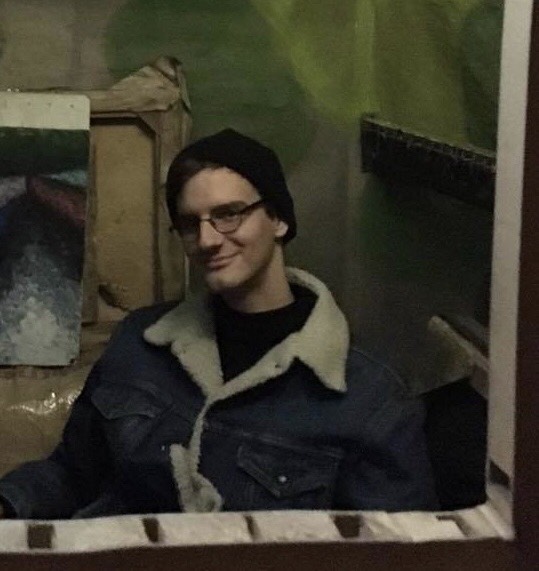Seaberry Juice in Extractivist Ruins: The Cosmopolitical Art of Diana Lelonek
Decades of open-pit mining has left the landscape of the Konin region in western Poland deserted, with the soil dry and hostile to plants. The coal producers, who are legally obliged to recultivate the post-mine landscape face a difficult task, but fortunately for them there are few plants whose needs meet the harsh reality of this barren land. For the seaberry plant (Hippophae), this sandy post-coal environment is just fine to grow, and the plant develops abundantly over the transformed land that was once exploited by the mining corporations. This essay explores the Hippophae of Diana Lelonek’s artistic project Seaberry Slagheap and locates it in the context of local and planetary attempts for conscious interspecies coexistence. I discuss Seaberry Slagheap next to other research-based artistic initiatives by Lelonek to identify her attentive cosmopolitical approach. Following the project’s relations with conscious consumerism and its reception during the 2018 United Nations Climate Change Conference, this essay also problematizes the idea of environmentally engaged art, alongside the dangers and traps that sometimes accompany such practices.

Diana Lelonek during the first seaberry harvest in September 2018. Image courtesy of the artist.
Konin’s Anthroposcenic landscape in search of imagination
As much as coal mining has perpetuated our entry into the Anthropocene and is destructive for the planetary environment, its effects are also impossible to overlook on the local level.(Christophe Bonneuil, Jean-Baptiste Fressoz, “Welcome to the Anthropocene,” in The Shock of the Anthropocene: The Earth, History and Us (London: Verso 2016), p. 3.) In the Konin Coalfield area in western Poland, for example, opencast mines have led to the degradation and complete transformation of the landscape: drying out lakes and groundwaters, forming slag heaps, and resettling entire villages. Today, Konin’s coal industry is doomed to fail, as the lodes will only last for another thirty years. However, the question of how to conduct the just transition of the region, the character of which is based on the energy and mining industry, remains unanswered.
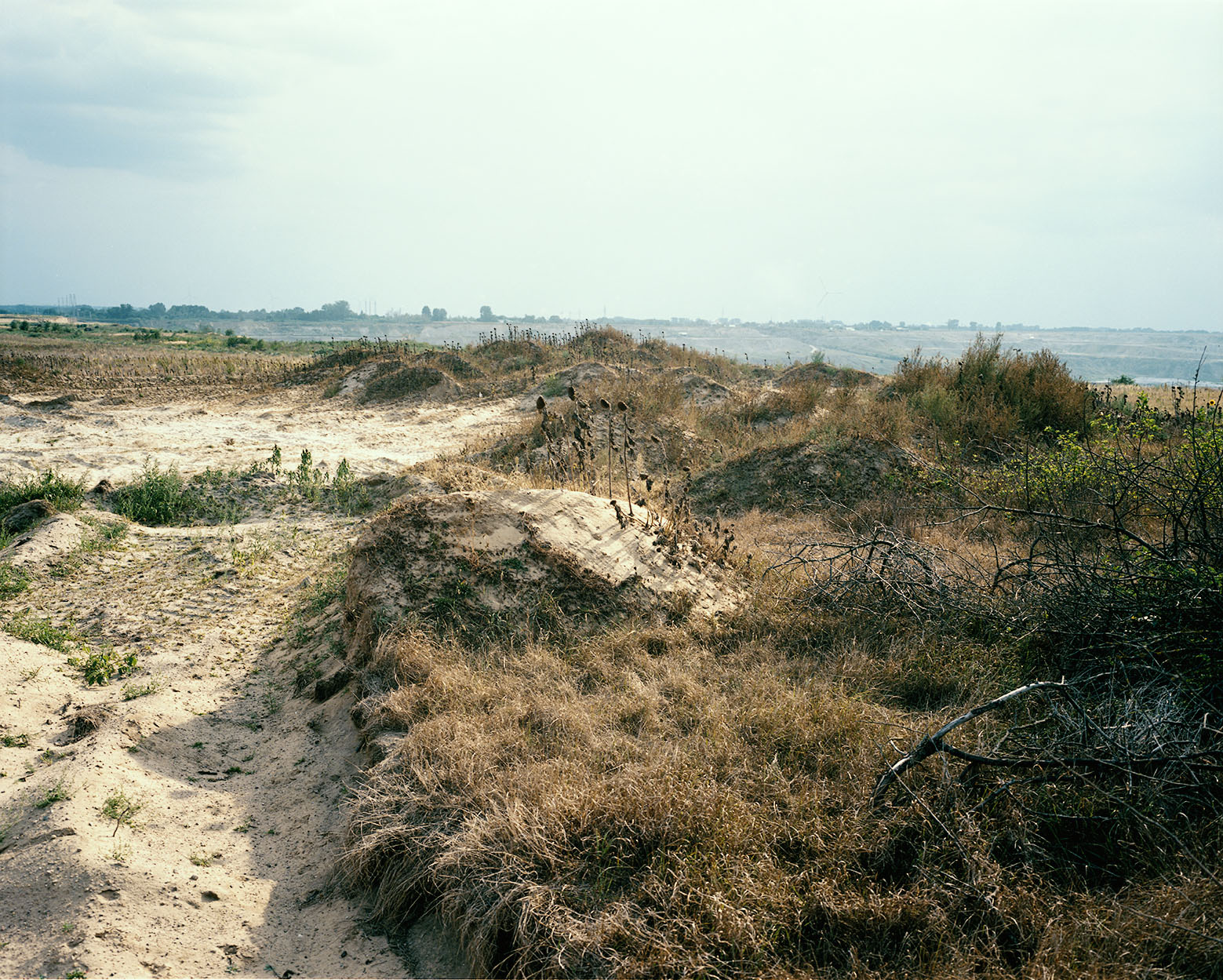
Diana Lelonek, “Deserted area around the open pit mine Jóźwin 2b in Kleczew,” 2018. Image courtesy of the artist.
Artist Diana Lelonek proposes to reinvent the region, or – to use a corporate new-speech – to rebrand it.(Diana Lelonek (b. 1988), is a visual artist who combines photography with other media, often using bio-art. She recently earned a PhD from the University of the Arts Poznan. She received several art awards such as Show Off during the Kraków Photomonth Festival, ReGeneration 3 at the Musée de l’Elysée in Switzerland and the Award of the Vordemberge-Gildewart Foundation. Among other institutions, her works were displayed in the Edith-Russ-Haus for Media Art in Oldenburg, Centre for Contemporary Art in Warsaw, Muzeum Sztuki in Łódź and during Riga International Biennale of Contemporary Art RIBOCA. She lives and works in Warsaw. ) She wants it to become a “seaberry basin,” and to develop a line of local food products made of seaberry, one of few plants that can easily grow on the dry coal slag heaps. Seaberry, or Hippophae, which grows abundantly in the barren soil of restored, post-mining areas in western Poland, is a plant native to the sandy soil of the seaside, and has great medicinal and therapeutic potential. Its fruits are “superfood” rich in vitamin C and antioxidants that are so desirable by the booming organic food industry. Seaberry Slagheap is Lelonek’s ongoing artistic project begun in fall 2018, as well as a real-life initiative specializing in products such as jams and juices made from seaberry. It offers a positive vision of development for this degraded region, and a solution that prioritizes small-scale manufactures and cooperatives over big companies. However, I argue that the project does more than that: in addition to being an inventive idea and utilizing the critical potential of aesthetics, it asks the question of what a new local community can be while engaging in the current debate about green capitalism.
Lelonek’s project creates a new vision for the future of the region, one that suffers not only from the effects of coal mining, but also from the lack of post-coal alternatives. As Miłka Stępień from the Polish Green Party explains:
The main problem in places such as Konin is the fact that, due to the collapse of the mining and coal-fired energy industry, there has also been a collapse in the sense of pride in the region. This is magnified by the fact that Konin has lost its status as the capital of the voivodship. One noticeable aspect of this is a sense of regression, magnified by the fact that people’s earnings are decreasing, there is an obvious decline in the amount of work available, migration is growing, and the society is aging. Another problem with places like Konin is that these territories have been left to a large extent to themselves. The state has not proposed any sort of concept for its development.(Marek Nowak, Miłka Stępień, “From Coal to Climate Action: Energy Transition In Poland,” Green European Journal, November 27, 2018, accessed March 27, 2019, https://www.greeneuropeanjournal.eu/from-coal-to-climate-action-energy-transition-in-poland/.)
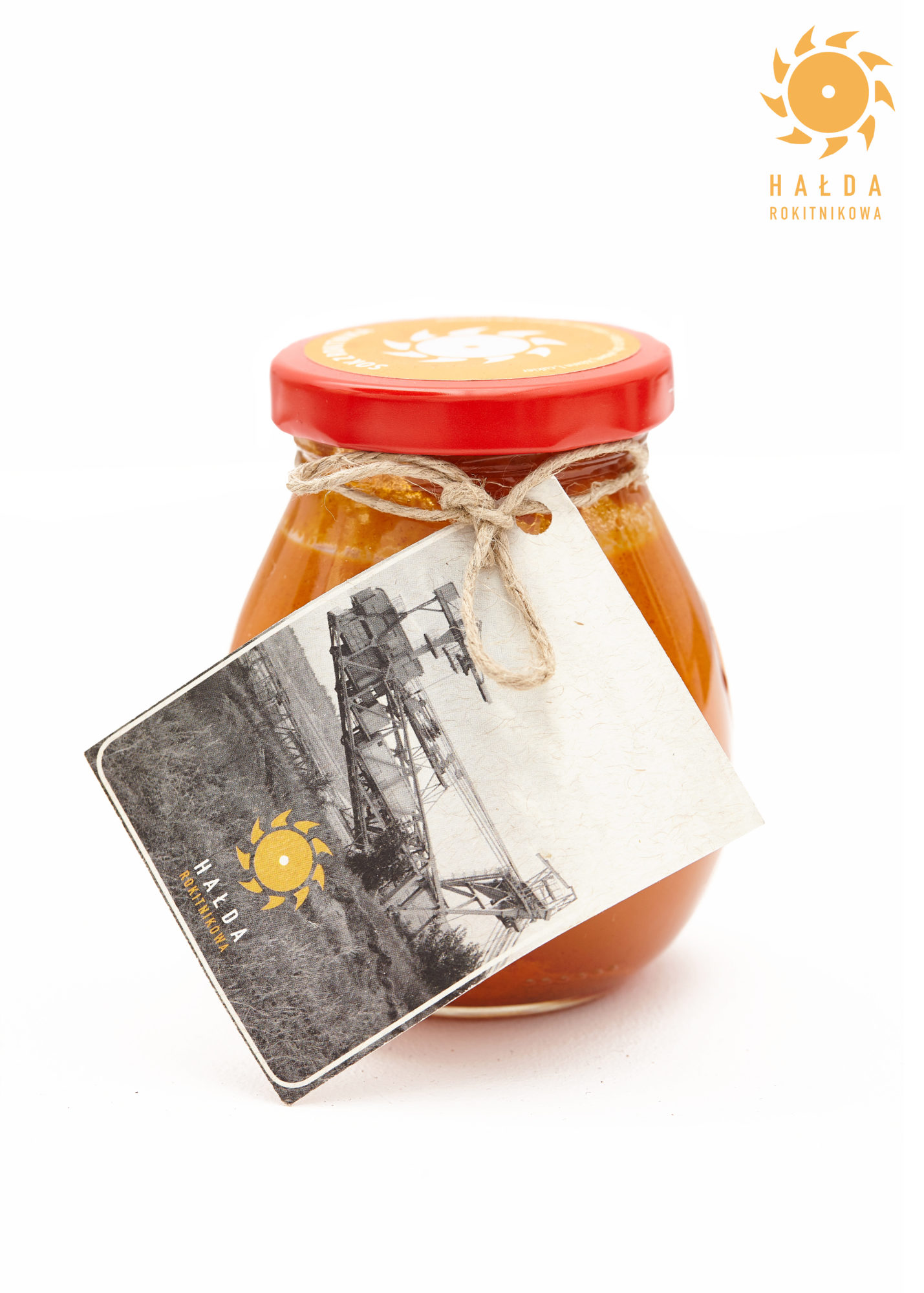
Diana Lelonek, “Seaberry Slagheap – detail of product,” 2018. Image courtesy the artist.
Konin developed substantially during socialism, when in the 1960s mines and power plants populated the area, together with urban infrastructure to accommodate newly migrated workers. But much of these industries came to an end, as they did not survive the shock therapy of the post-1989 economic transformation. The paradox is that despite the collapse of the industry, “very few people locally are fully aware of this fact and as a result, the myth of the region’s development is all the time seen as linked inextricably to the mining industry.”(Ibid.) Konin’s history and its current economic depression illustrate not only the collapse of the neoliberal dream in peripheral Poland but also the wider trajectory of extractivism, the dominant paradigm of advanced capitalism.(Sandro Mezzadra and Brett Neilson, “On the Multiple Frontiers of Extraction: Excavating Contemporary Capitalism,” Cultural Studies 31, no. 2-3 (2017).)
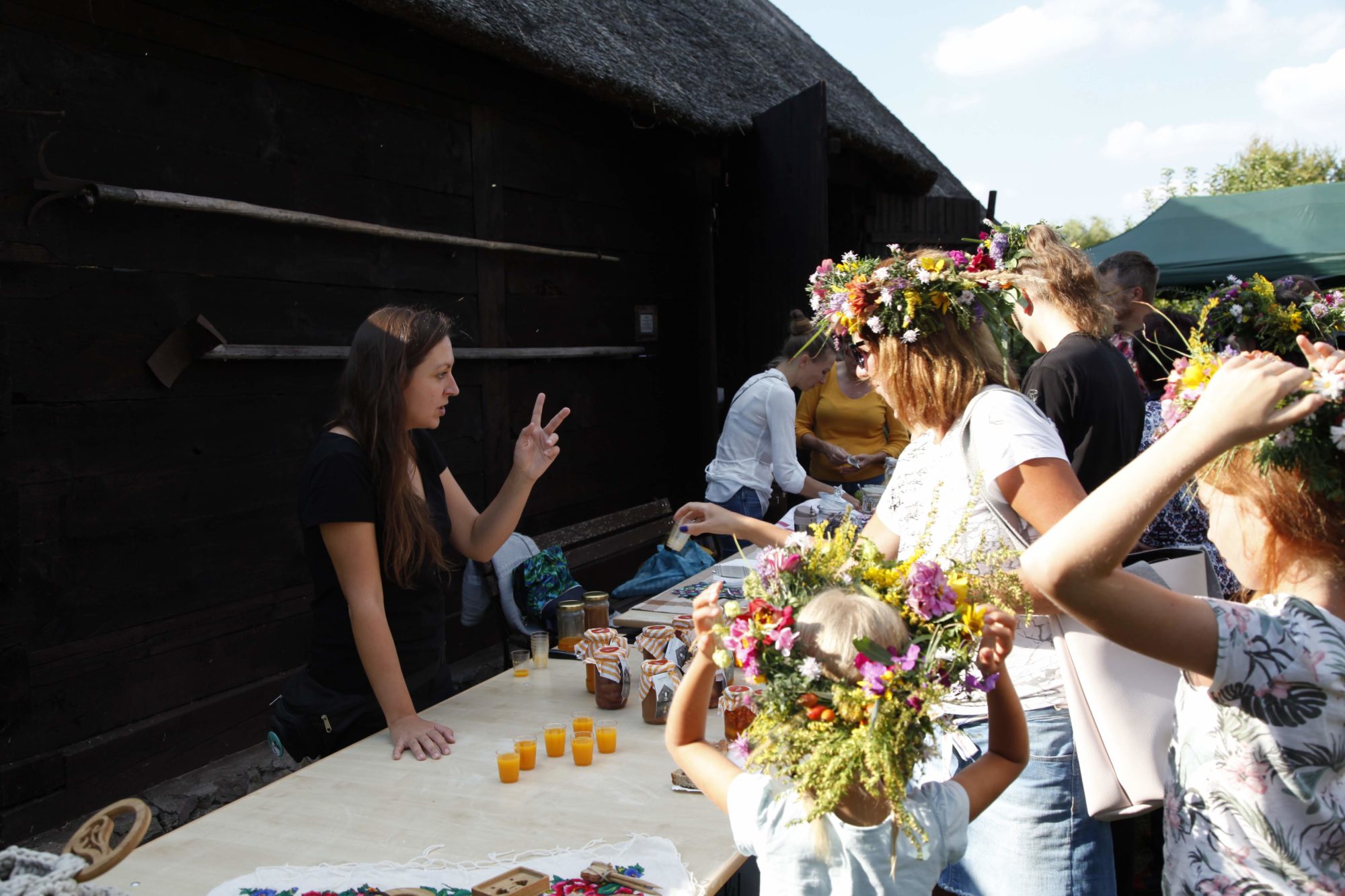
Diana Lelonek presenting Seaberry Slagheap during the traditional market in Konin, 2018. Photo courtesy of the artist.
Konin might be special, but it is by no means the only area in Poland that faces the challenges of deindustrialization. Similarly, Dąbrowa Górnicza, the artist’s hometown, was once rapidly transformed during the socialist industrial boom, but after 1989 the coal mines were gradually privatized then closed.
Lelonek’s artistic approach has evolved from photography to extensive research-based projects, driven by an attentiveness to different forms of human-nonhuman intersections, alongside an active stand for change. However, her activist approach reaches beyond the context of political, societal and even human systems, meeting the category of “cosmopolitics,” as defined by Isabelle Stengers.(Isabelle Stengers, “The cosmopolitical proposal,” in Bruno Latour, Peter Weibel (eds.), Making things public, (Cambridge, MA: MIT Press 2005), pp. 994-1003.) As opposed to liberal cosmopolitanism with its assumption of an already unified cosmos, the cosmopolitical idea describes the world we inhabit as a pluriverse, where the common world is not a given, but an aim to be achieved in the future. In principle, cosmopolitics are politics constructed without cliché references to binaries of nature and society.
As Bruno Latur notes:
The presence of cosmos in cosmopolitics resists the tendency of politics to mean the give-and-take in an exclusive human club. The presence of politics in cosmopolitics resists the tendency of cosmos to mean a finite list of entities that must be taken into account. Cosmos protects against the premature closure of politics, and politics against the premature closure of cosmos.(Bruno Latour, “Whose Cosmos, Which Cosmopolitics? Comments on the Peace Terms of Ulrich Beck.” Common Knowledge 10, no. 3, p. 454.)
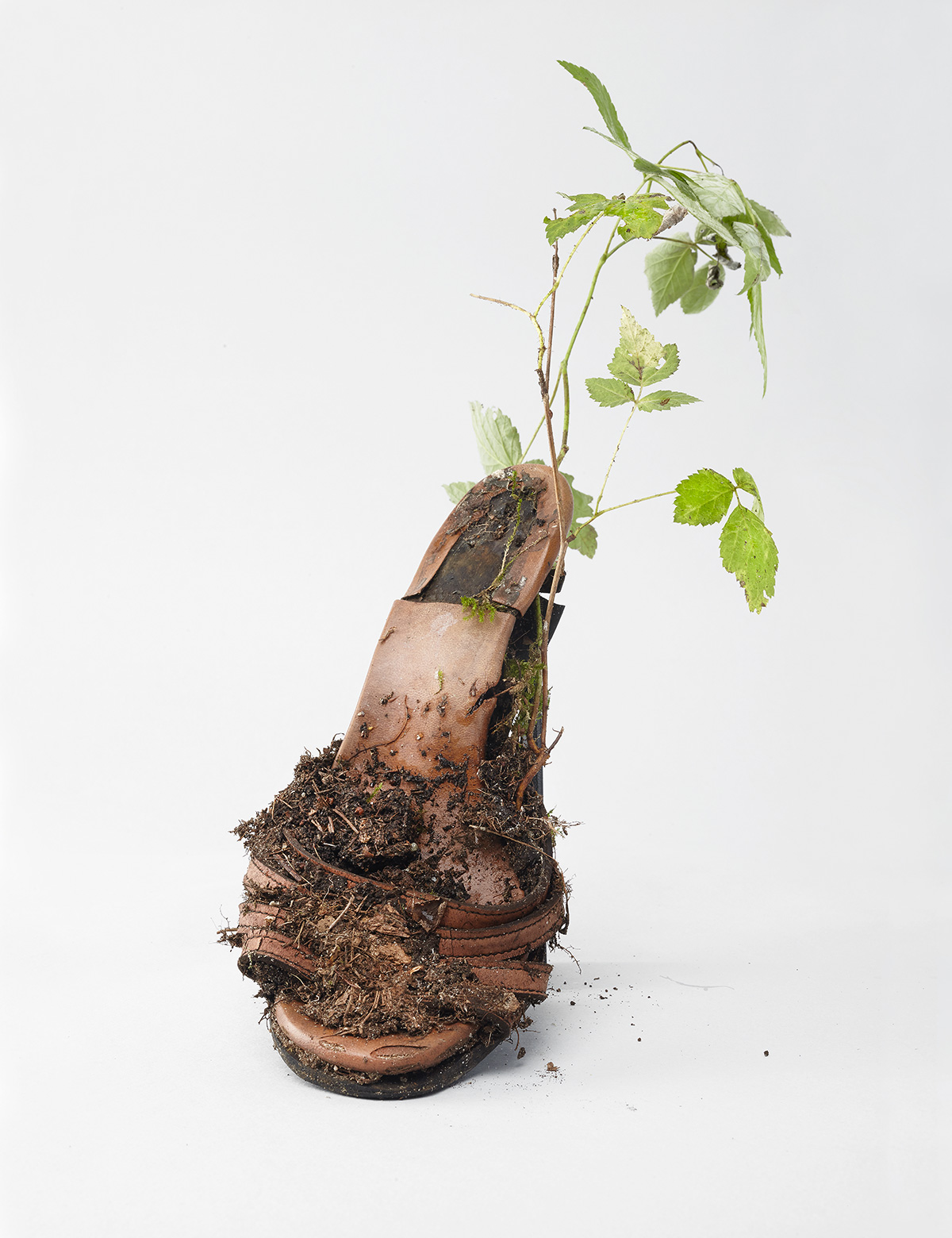
Diana Lelonek, Found object from the series “Center for the Living Things,” 100×70, 2016. Photo courtesy of the artist.
Lelonek’s Seaberry Slagheap speaks about humans and plants that inhabit the post-industrial region, but her earlier works focused mostly on the non-human actors within the environment. For example, her Institute for Living Things established in 2016 has been presented in diverse contexts, from a botanical garden in Poznań to the Riga International Biennial of Contemporary Art (RIBOCA).(See the project website: http://centerforlivingthings.com.) It is a growing collection of garbage-plants, found manmade objects that have lost their original function to become nutrition to various kinds of mosses and fungi. The objects (such as textiles or deformed plastic packaging) having lost their connections to the material culture where they were created, offer a glimpse to a world after humans, in which the remains of our civilization serve as a nutrition for other organisms. Similarly, her ongoing project Zoe-therapie (started in 2015) is a collection of microbe colonies, fungi and bacteria developed on the copies of classical European artworks and on portraits of canonized Western philosophers.(See “Zoe-terapia (w procesie) Diany Lelonek w Rodríguez Gallery,” Magazyn Szum, https://magazynszum.pl/zoe-terapia-w-procesie-diany-lelonek-w-rodriguez-gallery/.) In these works, the fungi takes over the images, and by dissolving the physical objects, it also (at least symbolically) overthrows an Anthropocentric and hierarchical vision of history.
Lelonek’s vision for Konin is also rooted in cosmopolitical sensitivity. It does not imply making the seaberry another resource exploited by an external agent, such as a producer representing a large food and beverage industry. Rather, the goal of the project is to create a community, in which the local inhabitants can realize the benefitial potential of the seaberry plant that was commonly used in folk treatments. As a result, the community should approach Hippophae with care and use it for the common benefit to end the region’s dependence on the heavy industry that poisons both plants and humans.
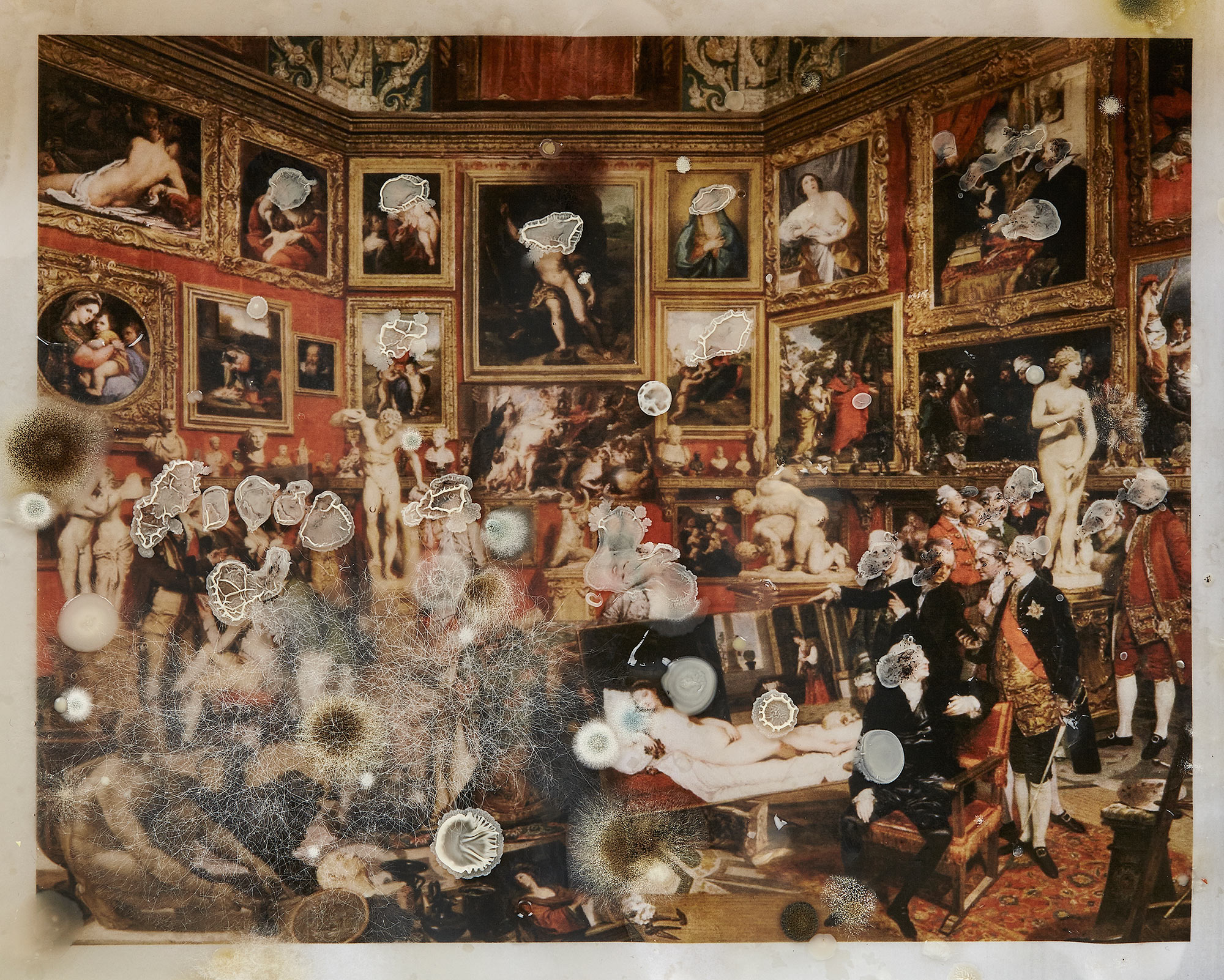
Diana Lelonek, Academy overgrown by various species of molds and bacterias, from the series “Zoe-Therapy,” 2017, 56×70. Image courtesy of the artist.
Ecology as commodity
The commercial-like stall created by Lelonek to present the Seaberry Slagheap in a gallery space, adopts an “ecological” aesthetic currently used by local farming cooperatives, as well as international corporations. Each of the seaberry products, such as juice or jam, resemble bioproducts one might find on the organic shelves of supermarkets. However, the labels on the jars reveal the background story of the Konin region, displaying images of abandoned houses due to the expansion of mines and of the radically transformed environment. The tension between the commercial character of the product and overwhelming tragedy of the environmental destruction is purposeful, as Lelonek appropriates a common feature of today’s capitalist discourse. As a result of advancing climate change, the system profits from the growing ecological awareness of society. Consumers are held responsible for the upcoming catastrophe, and consumption is presented as the only available method of saving the world.
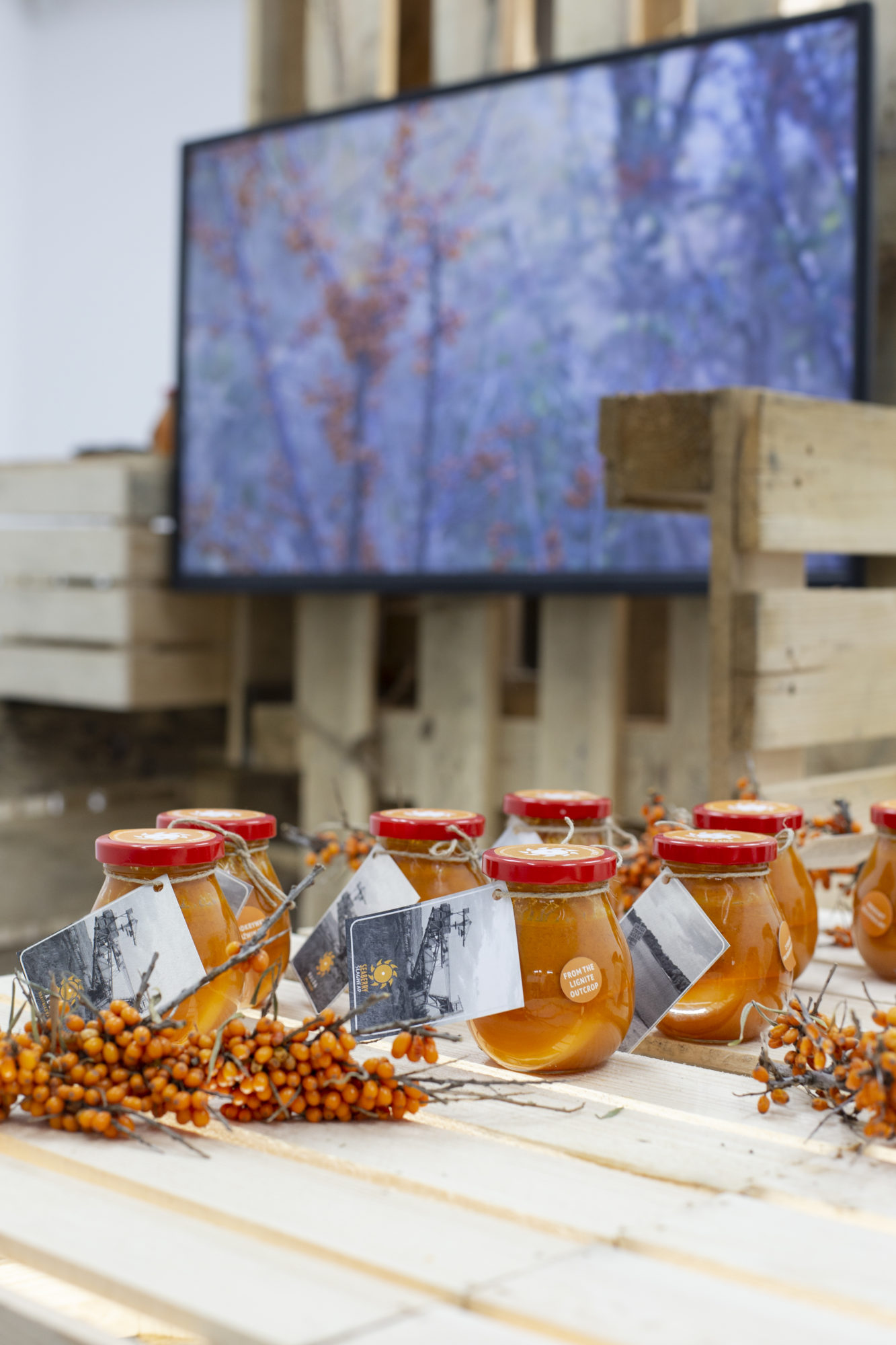
Detail of “Seaberry Slagheap” from the Most Beautiful Catastrophe exhibition, CCA Kronika in Bytom. Photo by Marcin Wysocki. Courtesy of Marcin Wysocki, CCA Kronika.
The stall structure of Seaberry Slagheap is made of fruit crates and wooden industrial pallets, which makes it entirely reusable and easy to recreate in any place then disassemble without creating waste. This zero-waste aspect of Lelonek’s work seeks to address some of the problems of environmentally oriented art, which often addresses the environment but contributes material waste. Some art that calls for the preservation of the environment often participates in the circuit of its destruction, by leaving its own carbon footprint.(See David Balzer, “The Carbon Footprint of Art,” Canadianart.ca, accessed April 1, 2019, https://canadianart.ca/features/the-carbon-footprint-of-art/ ) The stall is accompanied by an instruction book, resembling the furniture designs of Ikea – the McDonalds of the furniture world, which despite its commitment to sustainability, is a part of destructive mass-produced and low-cost consumerism.(For the discussion of IKEA and sustainability, see How Sustainable Is IKEA, Really? https://ecowarriorprincess.net/2018/03/how-sustainable-is-ikea-really/.)
Seaberry artivism
Seaberry Slagheap is an example of the mobilization in contemporary art around climate change, work that is consciously located in particular context while addressing the burning planetary issue. At the same time, the way in which the work functions outside of an artistic context also illustrates threats to the art-activist approach.
During the COP24 United Nations Climate Summit held in Katowice in December 2018, Seaberry Slagheap was presented in an exhibition in the nearby CCA Kronika in Bytom. The group exhibition The Most Beautiful Catastrophe, which I myself curated, aimed to critically reflect on the UN Climate Summit by bringing together the voices of artists and activists from Central Europe.(The Most Beautiful Catastrophe, CCA Kronika, Bytom, (January 12, 2018 – April 1, 2019). Curated by Jakub Gawkowski. See also the catalog Jakub Gawkowski, Paweł Wątroba (eds.), The Most Beautifuc Catastrophe (Bytom: CCA Kronika, 2019). ) Lelonek’s project was exhibited for the first time in the gallery space, but the artist also actively promoted it outside of the gallery’s white cube. The artist took part in a panel organized by Greenpeace, and was also invited to present the Seaberry project in The Good Climate – a pavilion made of straw and wood located in the center of Katowice, funded by the municipality to spread the ecological atmosphere among locals as part of the program accompanying COP24.
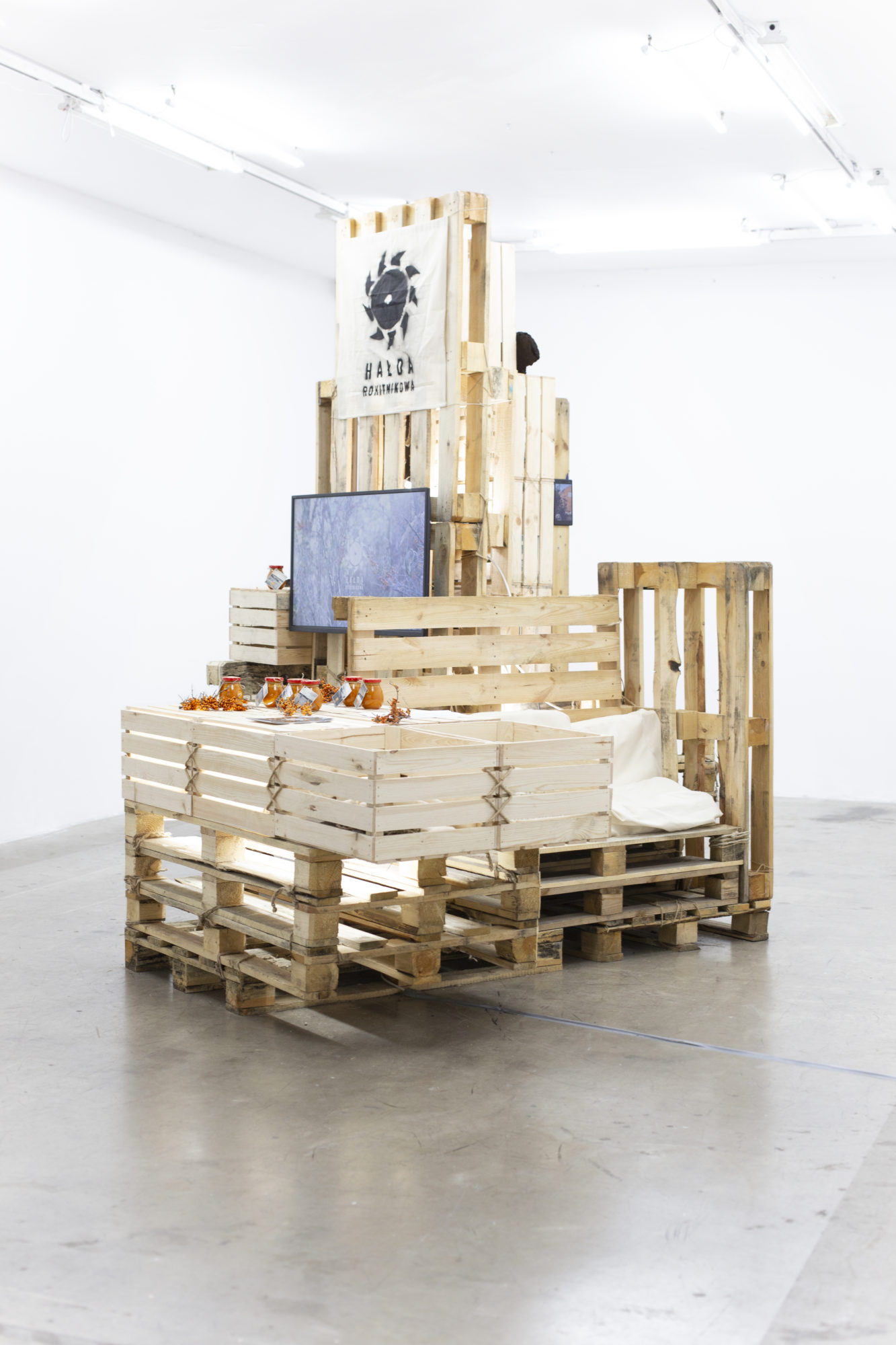
Diana Lelonek, Installation view of “Seaberry Slagheap” from The Most Beautiful Catastrophe exhibition. Photo by Marcin Wysocki. Courtesy of Marcin Wysocki, CCA Kronika.
As it turned out, while Seaberry Slagheap problematized the notion of green capitalism and conscious consumerism, the work itself became a self-fulfilling proficiency. As the artist soon discovered, the seemingly “ecological” pavilion, where people could learn about organic cosmetics, vegan diet and solar panels, was in fact a great operation in greenwashing and artwashing.(By greenwash and artwash I understand the use of artistic expression and discourse of environmentalism for the PR benefit of companies or political actors. See Mel Evans, Artwash: Big Oil and the Arts (London: Pluto Press, 2015).) Apart from workshops organized by McDonalds, the pavilion hosted events by companies that directly and extensively contribute to the destruction of the natural environment in Poland, such as giant coal producer Jastrzębska Spółka Węglowa.(Michalina Bednarek, ”Akcja Jastrzębskiej Spółki Węglowej w ekologicznym pawilonie na rynku. Artystka zażenowana,” [The action of JSW in ecologic pavilion on the market. Artist is disappointed] Wyborcza.pl, accessed March 30, 2019, http://katowice.wyborcza.pl/katowice/7,166970,24274963,akcja-jastrzebskiej-spolki-weglowej-w-ekologicznym-pawilonie.html.) The pavilion also hosted an event of the National Forests – a state-owned company responsible for the destruction and logging in the protected parts of Białowieża – the last primeval forest in Europe. Apart from breaking international agreements, the organization persuaded the prosecution of environmental protesters who blocked the logging.(See Arthur Neslen, “Poland violated EU laws by logging in Białowieża forest, court rules,” Guardian.com, accessed March 30, 2019, https://www.theguardian.com/world/2018/apr/17/poland-violated-eu-laws-by-logging-in-biaowieza-forest-says-ecj.)
Despite noble intentions, artists can often be utilized as pawns in initiatives that simply operate as an artwash.(Mel Evans, Artwash: Big Oil and the Arts (London: Pluto Press, 2015), p. 8. ) In the case of Lelonek, unlike other participating artists she decided to cancel her participation and boycotted the pavilion. By withdrawing from the pavilion, she gave away the chance to present her art, but also made sure her presence would not legitimize the event. This was not the last time when Lelonek consciously reflected on her own presence and agency as an artist and public person. When she received the cultural award of the weekly magazine Polityka, she used the air time on live TV to protest against a massive wild boar cull planned by the government.
Inhabiting damaged landscape
Seaberry is not native to Konin, and neither are the workers who have migrated to work in the local mines since the 1960s. Today, future generations of migrating humans and plants can contribute to the restoration of faith in the barren reality of this deserted anthroposcenic landscape of sand and slag heaps. The seaberry, similarly to the matsutake mushroom described by Anna Tsing,(See Anna Lowenhaupt Tsing, The Mushroom at the End of the World. On the Possibility of Life in Capitalist Ruins, (Princeton University Press 2015).) can become a precarious commodity that grows on the margins of human-disturbed territories or in the slits between them. To focus on the seaberry plant with the attentiveness it rarely gets is a lesson in living on extractivist ruins, on a soil deserted and sterilized due to the actions of aggressive capital.
With its cosmopolitical sensitivity rooted in the local reality, Seaberry Slagheap proposes a blueprint for action. It also raises the question of the utopian character of the whole project: can everyone produce seaberry jam and hope for the crisis to end? This simplified view is, of course, a misconception – the aim is not to produce another commodity, but to appropriate the act of production and to imagine different relations of power and economy, in which the local community is empowered and not exploited. While Lelonek’s approach is rooted in a market economy, it serves as a case study of how to engage with the landscape around us and look for solutions while living on a damaged planet.(For more on multispecies studies, see Vinciane Despret, Michel Meuret, “Cosmoecological sheep and the arts of living on a damaged planet,” Environmental Humanities, 8(1) 2016, pp. 24-36.)

